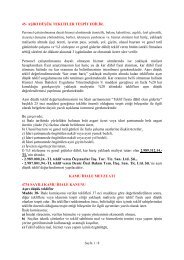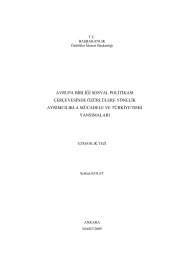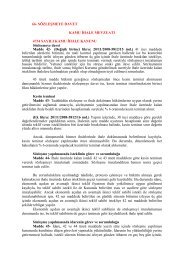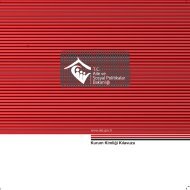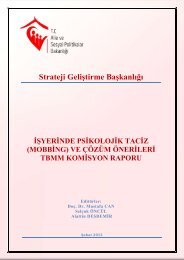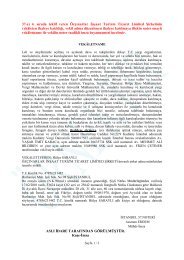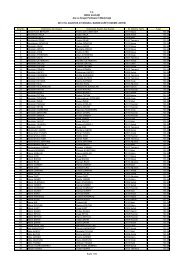Sosyal PolÄ°tÄ°ka tÄ°ka - EÄitim ve Yayın Dairesi BaÅkanlıÄı - Aile ve ...
Sosyal PolÄ°tÄ°ka tÄ°ka - EÄitim ve Yayın Dairesi BaÅkanlıÄı - Aile ve ...
Sosyal PolÄ°tÄ°ka tÄ°ka - EÄitim ve Yayın Dairesi BaÅkanlıÄı - Aile ve ...
- No tags were found...
Create successful ePaper yourself
Turn your PDF publications into a flip-book with our unique Google optimized e-Paper software.
A CRITICAL ASSESSMENT ON THE CONDITIONAL CASH TRANSFER PROGRAMME<br />
IN THE CONTEXT OF GENDERED POVERTY IN TURKEY<br />
Mehmet Ali KÜÇÜKÇAVUŞ<br />
po<strong>ve</strong>rty is not gender-neutral. Since women’s roles, including their participation in<br />
social life and employment, are limited differently compared to men by social values<br />
and norms of the society that they li<strong>ve</strong> in and economic limitations and go<strong>ve</strong>rnment<br />
policies, these differences underpins disparities and extend the gap between women<br />
and men as Bellamy and Rake point out (2005, p.2).<br />
Among these major differences are <strong>ve</strong>ry intensi<strong>ve</strong> participation of women in unpaid<br />
work, including child or elderly care and domestic work, that pre<strong>ve</strong>nts them to participate<br />
properly in paid work (Bellamy and Rake, 2005, p.2) and unequal distribution<br />
of income within households (Bugra and Keyder, 2005, p.6). These differences<br />
consequently resulted in more women felling into po<strong>ve</strong>rty and face the risk of social<br />
exclusion. That situation does not differ for the industrialised and de<strong>ve</strong>loped nations.<br />
For instance, women “…tend to be poorer than men and more women than men are<br />
poor…” in Britain (Bellamy and Rake, 2005, p.48).<br />
In the po<strong>ve</strong>rty literature, two main concepts and approaches regarding women in po<strong>ve</strong>rty<br />
were introduced gradually. These are “feminisation of po<strong>ve</strong>rty” and “gendered<br />
po<strong>ve</strong>rty” which is also defined as “gendered nature of po<strong>ve</strong>rty”. The term of feminisation<br />
of po<strong>ve</strong>rty firstly appeared in the debates on the single mothers and welfare in<br />
1970s. It was used to emphasize that “…women ha<strong>ve</strong> a higher incidence of po<strong>ve</strong>rty<br />
than men…[and]… their po<strong>ve</strong>rty is more se<strong>ve</strong>re than that of men…[and]…there is<br />
a trend to greater po<strong>ve</strong>rty among women, particularly associated with rising rates of<br />
FHHs [female-headed households] …“ (Bridge, 2001, p.1 ).<br />
The term of feminisation of po<strong>ve</strong>rty took place in a global policy papers for the first<br />
time in 1995 at the action plan of the fourth World Conference on Women due to<br />
the fact that po<strong>ve</strong>rty came into prominence in the international de<strong>ve</strong>lopment agenda<br />
and new approaches and indicators were strongly needed (General Directorate on<br />
the Status of Women, 2008b, p.5). Howe<strong>ve</strong>r, a clear definition on the feminisation<br />
of po<strong>ve</strong>rty was not included in this action plan. Instead, this action plan mainly<br />
required all relevant parties including go<strong>ve</strong>rnments, international organisations, academic<br />
institutions and private sector to de<strong>ve</strong>lop a methodology incorporating “gender<br />
perspecti<strong>ve</strong>” into process of economic policy making and collect gender based<br />
data on po<strong>ve</strong>rty (UN Women, 2011a). Despite of this uncertainty on the definition<br />
of feminisation of po<strong>ve</strong>rty in the conference documents, promoting “women’s economic<br />
independence, including employment” and eradicating “the persistent and<br />
increasing burden of po<strong>ve</strong>rty on women” were also listed in the critical areas of the<br />
Beijing Platform for Action (BPFA) in the closing declaration of the conference which<br />
is known as the Beijing Declaration (UN Women, 2011a).<br />
Although feminisation of po<strong>ve</strong>rty was widely discussed and included in international<br />
policy papers, there were also criticisms towards it. An article that was written by<br />
47



